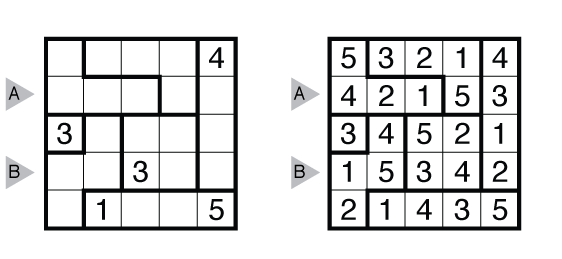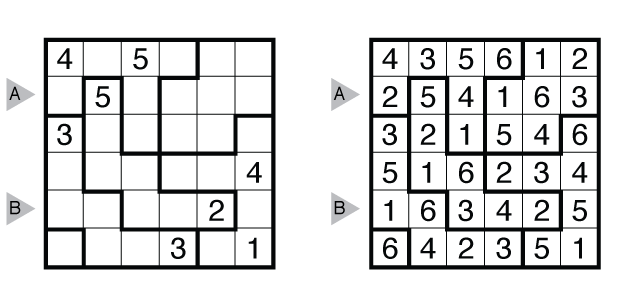Deficit/Surplus Sudoku R&I
Deficit Sudoku

Rules: Insert a number in the indicated range into each cell so that no number repeats in any row or column. Some regions appear with fewer cells than there are numbers in the indicated range. No number repeats in these regions, but not all numbers will appear in each of these regions.
Surplus Sudoku

Rules: Insert a number in the indicated range into each cell so that no number repeats in any row or column. Some regions appear with more cells than there are numbers in the indicated range. Some number(s) repeat in these regions, but all numbers in the indicated range must appear at least once within each of these regions.
Answer String: Enter the row/column marked “A”, followed by a comma, followed by the row/column marked “B”. Rows are entered from left to right and columns from top to bottom. The Deficit example has the key “42153,15342” and the Surplus example has the key “254163,163425”.
(Brief) History of Deficit and Surplus Sudoku: Descended from Sudoku. Deficit Sudoku was first developed by Wei-Hwa Huang, under the name Udoku, and presented to competitors at the 2nd World Sudoku Championship in Prague, Czech Republic. Deficit Sudoku compromises the standard sudoku solving technique of “Hidden Singles“, a topic that in discussions between Huang and Thomas Snyder led to the co-development of a counterpart that instead compromises “Naked Singles”. This counterpart, originally dubbed Ssudoku, is now known as Surplus Sudoku.
History of these examples: This Deficit Sudoku was written by Wei-Hwa Huang and this Surplus Sudoku was written by Thomas Snyder, both for the Puzzle Wiki and the 5th World Sudoku Championship Instructions.
Sources for Deficit/Surplus Sudoku: Follow this link for Deficit/Surplus Sudoku puzzles on this website. If you are new to this puzzle type, here are our easiest Deficit/Surplus Sudoku to get started on. More Deficit and Surplus Sudoku puzzles can be found in Mutant Sudoku and in future titles from Grandmaster Puzzles.
Design rules for contributors: A Grandmaster Deficit/Surplus Sudoku will have a unique solution that can be reached by logic alone. Generally, a Grandmaster Deficit/Surplus Sudoku should have a symmetric layout of givens, and may have a symmetric layout of regions but this is not required. The regions in a Deficit/Surplus Sudoku may have more than one cell missing/gained. Puzzles containing both deficit and surplus regions (and even normal-sized regions) are allowed.
